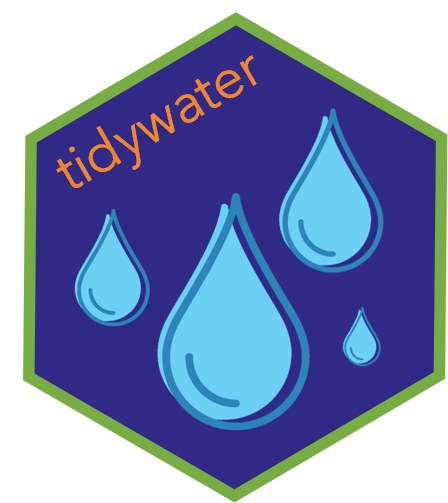
The hardware and bandwidth for this mirror is donated by dogado GmbH, the Webhosting and Full Service-Cloud Provider. Check out our Wordpress Tutorial.
If you wish to report a bug, or if you are interested in having us mirror your free-software or open-source project, please feel free to contact us at mirror[@]dogado.de.

Tidywater incorporates published water chemistry and empirical models in a standard format. The modular functions allow for building custom, comprehensive drinking water treatment processes. Functions are designed to work in a tidyverse workflow.
# Install tidywater from CRAN:
install.packages("tidywater")
# Alternatively, install the development version from GitHub:
# install.packages("devtools")
devtools::install_github("BrownandCaldwell-Public/tidywater")In this first example, acid-base chemistry and TOC removal models are demonstrated. This example uses tidywater base functions to model a single water quality scenario.
library(tidywater)
library(tidyverse)
## Use base tidywater functions to model water quality for a single scenario.
base_coagulation <- define_water(ph = 8, alk = 90, tds = 50, toc = 3, doc = 2.8, uv254 = 0.08) %>%
chemdose_ph(alum = 30) %>%
chemdose_toc(alum = 30)
#> Warning in chemdose_ph(., alum = 30): Sulfate-containing chemical dosed, but
#> so4 water slot is NA. Slot not updated because background so4 unknown.To model multiple water quality scenarios, use tidywater’s helper functions (x_chain or x_once) to apply the models to a dataframe.
## x_chain functions apply models to a list of "waters", and output a list of "waters" so that
## the data can be piped into the next tidywater model.
coagulation <- water_df %>%
define_water_chain(output_water = "raw") %>%
mutate(alum = 30) %>%
chemdose_ph_chain(input_water = "raw", output_water = "phchange") %>%
chemdose_toc_chain(input_water = "phchange", output_water = "coag")
#> Warning: `chemdose_toc_chain()` was deprecated in tidywater 0.10.0.
#> ℹ Please use `chemdose_toc_df()` instead.
#> This warning is displayed once every 8 hours.
#> Call `lifecycle::last_lifecycle_warnings()` to see where this warning was
#> generated.
#> Warning: `chemdose_ph_chain()` was deprecated in tidywater 0.10.0.
#> ℹ Please use `chemdose_ph_df()` instead.
#> This warning is displayed once every 8 hours.
#> Call `lifecycle::last_lifecycle_warnings()` to see where this warning was
#> generated.
#> Warning: `define_water_chain()` was deprecated in tidywater 0.10.0.
#> ℹ Please use `define_water_df()` instead.
#> This warning is displayed once every 8 hours.
#> Call `lifecycle::last_lifecycle_warnings()` to see where this warning was
#> generated.
## To get out individual parameters, use `pluck_water`
coagulation <- coagulation %>%
pluck_water(input_waters = c("raw", "coag"), parameter = c("ph", "doc"))Note that these functions use a “water” class. The “water” class is
the foundation of the package; it provides a mechanism for linking
models in any order while maintaining water quality information. The
define_water function takes water quality inputs, but
define_water_chain may be used to convert a dataframe to a
list of “waters”.
For more detailed examples on tidywater functions and how to use
“water” class data, please see the tidywater vignettes:
browseVignettes("tidywater")
This project is maintained by volunteers and is provided without warranties or guarantees of any kind.
Use at your own risk. For official support, please contact Brown and Caldwell.
Please read our CONTRIBUTING.md and SECURITY.md before submitting issues or pull requests.
These binaries (installable software) and packages are in development.
They may not be fully stable and should be used with caution. We make no claims about them.
Health stats visible at Monitor.